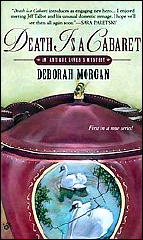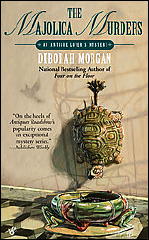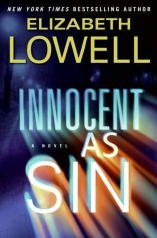April 2009
Monthly Archive
Sun 26 Apr 2009
A Review by DAVID L. VINEYARD:
K. K. BECK – The Revenge of Kali-Ra. Mysterious Press, hardcover, 1999. No paperback edition.
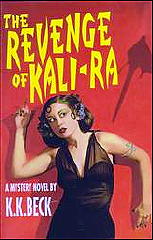
A friend and I have a special category of book we refer to as Dollar Store Wonders. You are all familiar with the various Dollar, .99 Cent, and $1.09 stores around the country, and have probably noticed occasional racks or tables of remaindered books lurking in odd corners with big round stickers announcing their bargain prices.
They vary from over prints of bestsellers to celebrity bios to westerns, sf, fantasy, horror, thrillers, juvenile series, and even a few actual mysteries.
It’s in the latter category that you are most likely to find one of the rare Dollar Store Wonders that make the hunt worth your time, a first class book that for some reason you missed entirely when it came out, and has now made its way to the last hope of new books before the second hand book store, the library sale, or the card table at the nearest garage sale.
One such Dollar Store Wonder is K.K. Beck’s The Revenge of Kali-Ra.
Beck gives the reader fair warning in the dedication to what she is up to:
“This book is affectionately and respectfully dedicated to the memory of Sax Rohmer, the Baroness Orczy, H. Rider Haggard, E. Phillips Oppenheim, and all the others, who toiled ceaselessly for no reward other than vast fame and massive fortune.”
In The Revenge of Kali-Ra Beck’s targets are broad ones — the overheated pulp work of Sax Rohmer and his ilk, and the overheated egos and money grubbing ways of Hollywood.
The heroine of the book is Melanie Oakley, the personal assistant to movie star Nadia Wentworth, who has just discovered the novels of Valerian Ricardo, who made a fortune churning out the adventures of Kali-Ra, the Queen of Doom, a beautiful and evil seductress with a taste for the trappings of S&M, or as the hero observes, “a low rent Story of O.”
Nadia thinks the time is ripe for Kali-Ra to stalk the screens of megaplexes all over the country and sets out to acquire the rights to Ricardo’s books. Which is the point at which the woodwork erupts.
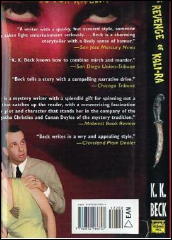
Nick Iverson is a great nephew of Ricardo’s who wants to know more about his family history. Lila Ricardo is the great man’s whacked out widow and Quentin Smith an unscrupulous lawyer for Maurice Fender who owns the rights to the Ricardo books and wants to cash in. In addition there’s Glen Pendergast, an academic who penned a study of the Ricardo oeuvre The Whip Hand: Issues of Gender in Genre in the Novels of Valerian Ricardo.
Then there’s Gail and her daughter Callie, a more-or-less normal post-teenager with a penchant for running around near naked and impersonating Kali-Ra, her namesake. Of course they all end up at Nadia Wentworth’s exotic Hollywood mansion, and then one of the uninvited guests shows up dead and Internet fans of the masters works start stalking the night, and we’re ready for a wacky twist on Agatha Christie where nothing and no one is quite what we expect them to be.
Among the many delights of the book are several overheated passages of Ricardo’s prose that are among the best evocations of the fractured prose stylings of the past you will encounter in many a day.
It’s no easy thing for a good writer to write badly well, and Beck pulls it off with real panache. You may even find yourself wishing she had actually written a full novel of the adventures of Kali-Ra to accompany the book, or at least a short story. The brief passages are tantalizing.
“I will always walk among you, often disguised as the humblest of serving girls, but in truth my power is constant and my slaves numerous and ever present. And even you Raymond Vernon, who mock me and pretend to think I can be stopped you are truly one of my slaves as well.”
The Revenge of Kali-Ra is a truly funny book. The people are bright and brittle. and the humor barbed but never cruel. It’s a fast read full of attractive protagonists and eccentric everyone else and begs for a film treatment.
Kali-Ra will rise again. You can’t keep a really good bad girl down.
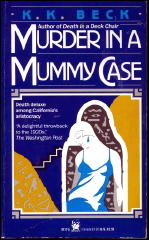
Beck had written fourteen books at the time of Revenge, including Murder in a Mummy Case, Young Miss Cavendish and the Kaiser’s Men, The Body in the Volvo, and four entries in her Jane Da Silva series. They are all bright and funny mysteries that combine real wit with appealing mysteries and a quirky but assured style that is among the most readable in the genre.
K.K. Beck made her way into the mystery scene carving a niche of her own in the humor category. But where much of the humor genre is decidedly in the cozy tradition, Beck has always had a streak of Marx Brothers style insanity in her best work, a wry twist of the knife that lifts her novels to another level.
Though her work falls in the classical style and form there has always been a hint of the screwball school lurking under the cozy surface. Beck goes for the quiet but knowing smile and the gentle laugh as often as not, but she is also likely to go for the belly laugh, the slapstick, knock down, roll in the aisle laugh. She also has an eye for the sharp barb, as in Nick’s Grandpa’s assessment of Nadia Wentworth:
“Movie stars!” snorted Grandpa. “I don’t keep track of any of them. Nice pair of bazongas, though …”
Although Beck comes from another tradition, the true screwball voice of Jonathan Latimer, Craig Rice, Dwight Babcock, Norbert Davis, and Richard Sale sings from her word processor. The Revenge Of Kali Ra is a romp, a playful send up of writers of popular fiction, Hollywood, and the grand old literature of the purple prose school.
But I warn you, you may never read Fu Manchu or Sumuru with a straight face again — assuming you could keep a straight face the first time you read them. And for a Dollar Store Wonder it is a prize above rubies, or at least one heck of a bargain.
Sat 25 Apr 2009
REVIEWED BY WALTER ALBERT:
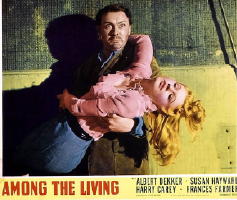
AMONG THE LIVING. Paramount, 1941. Albert Dekker, Susan Hayward, Harry Carey, Frances Farmer, Gordon Jones, Jean Phillips, Ernest Whitman. Director: Stuart Heisler. Shown at Cinevent 20, May 1988.
Story: One of two identical twin brothers, mentally insane, has been hidden away from the world for twenty-five years. When he escapes, the good twin is blamed for the other’s crimes.
This uneven but interesting film, directed by Stuart Heisler, also responsible for The Monster and the Girl (Paramount, 1941), begins with a marvelous tracking shot, traveling from a gloomy mansion to a graveside burial service.
There are at least two other scenes in the film that are also visually exciting. In the more memorable, Albert Dekker, playing the psychotic twin of the good/bad pairing, is tracked by an overhead camera shooting at an angle as he pursues an increasingly frightened woman along dark, deserted, rain-glistening back streets.
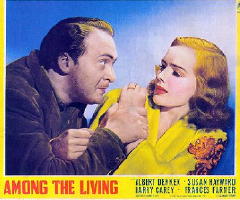
The camera-work is intermittently superb; the back-lot theatrics of this Southern Gothic thriller are something else again in spite of an interesting cast, with Dekker flanked by three attractive actresses, Susan Hayward, Jean Phillips and Frances Farmer, with Phillips particularly effective as the girl pursued by Dekker.
The program notes, written by William Everson, characterized this appropriately as a “blend of film noir and horror,” but it’s the film noir elements that are the more arresting.
– From The MYSTERY FANcier, Vol. 10, No. 3, Summer 1988, slightly revised.
Fri 24 Apr 2009
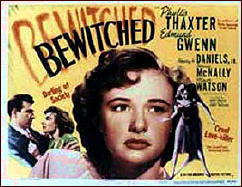
BEWITCHED. MGM, 1945. Phyllis Thaxter, Edmund Gwenn, Henry H. Daniels Jr., Horace McNally, Addison Richards, Kathleen Lockhart, Minor Watson. Screenwriter & director: Arch Oboler, based on his story for radio, “Alter Ego,” starring Bette Davis.
Giving away the entire story line, but what can I do, this is probably the first film about dual or multiple personality disorder, well before either Lizzie (with Eleanor Parker), and The Three Faces of Eve (with Joanne Woodward) both of which came out in 1957, some twelve years later.
Phyllis Thaxter plays Joan Ellis in Bewitched, a slim young girl engaged to be married who hears voices in her head – or rather one other voice, that of “Karen” (an unbilled – and unseen, alas – Audrey Totter), and who runs away to New York City from her small town in the Midwest to escape it (or her, as the case may be).
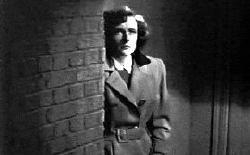
But there, while possessed by Karen, she commits a murder, and it’s bang up to midnight on Death Row as an elderly but sage psychiatrist (Edmund Gwenn) tries to convince the governor that a pardon might be in order.
A couple of scenes suggest this movie might be called a film noir, although a minor one. The first in particular – a rainswept street with Joan huddled in an alleyway as she tries to escape the demon inside her – suggests there might be more to the movies than there turns out to be.
But double alas, no. Arch Oboler, noted for his work on early 1940s radio, primarily as a writer and producer for the famed horror series Lights Out, turned more and more heavy-handed as time went on, and the movie Bewitched is no exception.
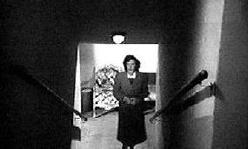
Determined that a moral be raised and stated (if not overstated) in many of his later productions, Oboler manages to suck much (but not all) of the enjoyment out of what could have been a first rate thriller. Granted he was working on a budget, but none of the parts of this film seem to jell.
Nor should anyone come away from watching this film thinking that exorcising extra personalities from someone so afflicted can be as easy as talking to them sternly.
Fri 24 Apr 2009
THE GOLDEN AGE OF BRITISH MYSTERY FICTION, PART V
Reviews by Allen J. Hubin.
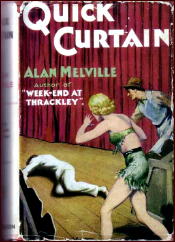
Amusing and satirical and worth tracking down is Alan Melville’s Quick Curtain (Skeffington, 1934). Inspector Wilson of the Yard is in the audience when an actor plays dead with unseemly realism in the first act of the London premiere of “Blue Music,” a musical extravaganza staged by the redoubtable Douglas B. Douglas.
The corpse is the star, the also redoubtable (if innocent of talent) Brandon Baker, whose fans number in the passionate hundreds of thousands.
Wilson takes change in his own inimitable way, abetted and confounded by his journalist son, Derek. Wilson has an idea that the apparent killer (who committed suicide thereafter) is innocent, and accumulates evidence to prove his theory.
Fortunately it all fits together SO neatly, even if rather messily for another member of the cast…
Inspector Geoffrey Boscobell features in thirteen of Cecil M. Wills’ detective stories, and Fatal Accident (Hodder & Stoughton,1936; Ramble House, 2007) is about midway through the series.
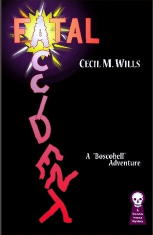
Here wealthy Stephen Merrivale successfully casts himself for death: he discards a tempestuous mistress, stands exposed in perfidy to his wife, drives from his home the photographer who has befriended his wife, and regularly antagonizes his nephew, whom he keeps on a very short leash.
So Merrivale’s corpse comes as no surprise, except that he seems to have died in a car accident in which a random passing motorist may have been culpably negligent.
These events in due course come to the attention of the Yard. Boscobell travels to the rural scene and finds a wealth of suspects, but the death stubbornly remains an accident, despite his instincts and efforts…
Another generally competent product of the Golden Age, though the means of death is rather pulled from a convenient hat.
The Griffith Case by John Bentley (Eldon, 1935) chronicles the second of nine investigations by Sir Richard Herriwell, noted antiquarian and amateur sleuth, whose “usual procedure is to accept a certain conclusion and then work back to prove it.” (The book is subtitled: “A Problem in Inductive Reasoning.”)
He assists Scotland Yard’s Chief Inspector Barton, a bluff policeman not given to subtleties. Here Marcus Griffith, a wealthy and odious moneylender, is stabbed to death in his country residence.
As with most unloved murder victims, various suspects appear; indeed, a confession is forthcoming in due course. But Herriwell is not satisfied… Nor, hugely, was I; this seems but an unremarkable product of detection’s golden age.
NOTE: Go here for the previous installment of this column.
[EDITORIAL COMMENT.] Fender Tucker, head man at Ramble House, is doing his best to get some of these gems of the “Golden Age” back in print, and in fact some of the books he publishes are true First US Editions.
Such is the case for Fatal Accident, by Cecil M. Wills. That’s the cover you see up above. My suggestion? Follow the link and encourage him to keep publishing books like this one!
Thu 23 Apr 2009
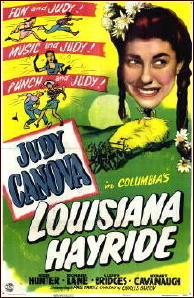
LOUISIANA HAYRIDE. Columbia, 1944. Judy Canova, Judy Canova, Ross Hunter, Richard Lane, George McKay, Minerva Urecal, Lloyd Bridges, Matt Willis, Hobart Cavanaugh. Director: Charles Barton.
Let me start out by saying that is indeed a crime movie, no matter what you may have deduced to the contrary, based on the title of the film and who the leading star is.
Judy Canova plays a country bumpkin in this movie – no surprise there, right? – who’s swindled out of her farm’s oil option money by two rambling grifters – two rambles ahead of the law – who promise her a career in Hollywood. The leading role, in fact, in a movie called — you guessed it — Louisiana Hayride.
Little do these guys know what they’re in for. You’re probably one step ahead of me, and for that matter, I’ll let you stay there.
Canova made an entire career of looking homely, with pigtails and Hee Haw costumes long before Hee Haw came along and gave hillbilly music a bad name. But her brand of youthful innocence, combined with a good-natured honesty and a strong sense of humor, usually at the expense of city slickers like the pair of crooks in this movie, made her a star in the 1940s, at least in small town America.
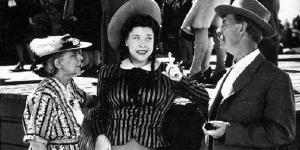
I wonder if her movies ever played in Boston or New York City. They did in Cadillac, that small town in Michigan’s upper lower peninsula where I grew up, although this particular one is almost as old as I am.
In spite of her incessant mugging for the cameras, Canova really did have a good singing voice, which is on display to great advantage several times in Louisiana Hayride. A pair of songs I recognized immediately were “Shortnin’ Bread” and “Put Your Arms Around Me, Honey,” which probably tells you more about me than you want to know.
Besides being a better than average belter of southern fried song hits, Judy Canova was also not quite as homely as the characters she played on the screen. I found this photo of her taken when she was older, and to me, she’s quite a handsome looking lady.
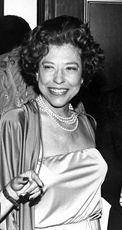
There are jokes being cracked and funny business going on continuously in this movie, in between the songs, that is, and I have to tell you I enjoyed them all, still being a small town kind of guy at heart.
PostScript. I nearly forgot to mention that Judy Canova was also a hit on radio, with her self-named series running on NBC from 1945 to 1953, which is essentially when her movie career came to a close as well.
You can listen to four episodes online here, and with a little searching, I’m sure you can find more.
Among the group of regulars in the cast were Hans Conreid, Mel Blanc and Sheldon Leonard. (One of these fellows came up for discussion not too long ago, as regular readers of this blog will quickly recall.)
Thu 23 Apr 2009
A 1001 MIDNIGHTS Review
by Marcia Muller:
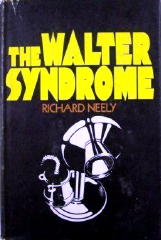
RICHARD NEELY – The Walter Syndrome. McCall Publishing Co., hardcover, 1970. Paperback reprint: Signet, 1971.
Lambert Post is a mild-mannered classified-advertising phone solicitor for the New York Journal. His association with the silver-tongued Charles Walter begins quite innocently, as he listens to Walter flatter landladies into placing “rooms to let” ads in the paper.
Walter, whose upper-class background and ease with people impresses Post, finds a “most fascinated and sympathetic audience” in him, and soon he progresses from boasting of his exploits to enlisting Post’s participation in a little game: Walter gets the names of recent widows and divorcées from the paper, then calls them up and makes a date; but Post is the man who shows up, explaining Walter has been called out of town.
Quickly the encounters turn ugly. One woman humiliates him in front of a roomful of guests; another has her boyfriend beat him up. Angry at the women’s treatment of Post, Walter embarks on a plan of revenge.
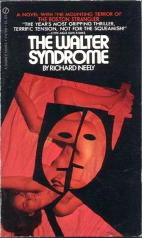
The first woman, Jennifer Hartwick, is knocked unconscious, raped, and left in a room at a hotel; because of an anonymous call, the police think she is a prostitute. The second woman, Diane Summers, and her boyfriend, Edward Cranston, are found shot to death.
At first the police suspect a murder/suicide, but then they find that a third party purchased the gun; and Walter — ever protective of Post — realizes that Lambert can be identified not only as the man who bought the weapon but also as someone with a grudge against Jennifer Hartwick. Thus, he reasons, Jennifer must die, too.
Soon the papers are carrying stories about the Executioner, a man who punishes women for their wickedness. And as investigative reporter Maury Ryan of the Journal delves into the case, the Executioner begins to contact him by phone, throwing out teasers and taunting him.
Told from the viewpoints of Post, Walter, and Ryan, this is a truly frightening tale. By the time a fourth woman is murdered and we realize the Executioner’s plans for fifth, it is impossible to put the book down.
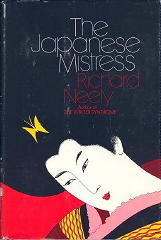
While the astute reader may pick up on what is going on fairly early, the outcome is nonetheless chilling — and the ultimate revelation is a total surprise.
Neely has written other tales of psychological suspense among them Death to My Beloved (1969), The Japanese Mistress (1972), Lies (1978), The Obligation (1979), and Shadows from the Past (1983).
———
Reprinted with permission from 1001 Midnights, edited by Bill Pronzini & Marcia Muller and published by The Battered Silicon Dispatch Box, 2007. Copyright © 1986, 2007 by the Pronzini-Muller Family Trust.
Thu 23 Apr 2009
RICHARD NEELY – A Madness of the Heart. Crowell-Collier, hardcover, 1976; Signet, pb, 1977.
Richard Neely specializes in the novel in which nothing is what it seems. This book is no exception. It tells of Harry Falcon, who saves a girl from rape only to return to his home and find his own wife (just released from a sanitarium) raped and beaten.
As a rapist begins to terrorize the city, Harry becomes obsessed with finding him and extracting vengeance. In the course of things he meets his childhood sweetheart, and their romance is rekindled; but as he recalls their past love, we learn some strange things about Harry Falcon.
Everything falls into place in the end, and the reader begins to see how cleverly Neely has planted little hints all along. Events and phrases take on new meanings as the truth is revealed.
This is a suspense story which carries you right along. The shocking ending might not be as great a surprise to readers of certain detective novelists as it will be to others, but it’s a strong one nevertheless.
– From The MYSTERY FANcier, Vol. 3, No. 3, May-June 1979.
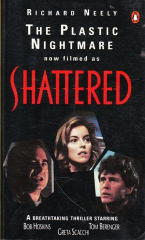
[EDITORIAL COMMENT.] In my opinion, Richard Neely’s books were like no one else’s. Noirish and dark and nothing in them is ever exactly what it seems to be. I’ve found a short piece about him on one of Ed Gorman’s former blogs. You can go here to read the whole article, but I don’t think he’ll mind if I include a short excerpt here, one in which he’s discussing The Plastic Nightmare, another of Neely’s works:
“Neely loved tricks as much as Woolrich did and
Plastic is a field of land mines. He even manages to spin some fresh variations on the amnesia theme. It’s as noir as noir can be but mysteriously I’ve never seen Neely referred to on any noir list. My theory is that his books, for the most part, were presented in such tony packages, they were bypassed by mystery fans.”
Wed 22 Apr 2009
REGINALD HILL – Ruling Passion. Dell, paperback reprint; Scene of the Crime #51; first printing, August 1982. Hardcover editions: Collins/Crime Club, UK, 1973; Harper & Row, US, 1977. Reprinted many times, both hardcover and soft.
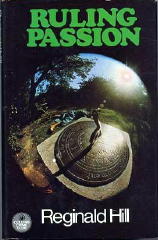
Chronologically the third of the Superintendent Dalziel–Sergeant Pascoe novels, of at least 20 and still counting, and only the second that I’ve managed to sit down and read. The first one is lost to memory — to mine, at least. I could hazard a guess as to which one it was, but that’s all it would be, a guess.
But even so, I could tell that the uneasy rapport (of sorts) between Pascoe and Dalziel was still going through some growing pains in Ruling Passion, the overweight (fat) Dalziel thinking of himself as a mentor, and Pascoe, if indeed a student, often wishing that he had a different master.
If you’re a long-time reader of the series, feel free to chip in. How has their relationship grown and changed over the years?
The two cases in Ruling Passion are really both Pascoe’s. The one in which he’s more deeply involved is the more interesting of the pair, and he’s not even the investigating officer. He and Ellie Soper, a friend from college days with whom he’s been recently reunited, getting together with four other friends from that time of their life, shockingly find three of them dead — murdered. Missing, and presumably the killer (although not to Pascoe’s way of thinking) is the husband of one of the three.
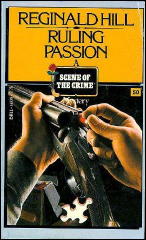
The other case, the one to which he’s officially been assigned, is that of a series of house break-in’s that have recently taken place while the owners have been away. A fairly innocuous case, but there are signs that — as opposed to the usual burglar — this one will put up a fight if he’s cornered.
This was a long book in 1973, unusually so, with over 300 pages of small print in the paperback edition I read; while it may run closer to today’s norms, I still found it long. The big question (to mystery readers) is whether or not the two cases are connected. Hill’s books can be difficult to get a good read on, or so I’ve been told, so it’s not so clear cut that the two cases are really one — and I won’t tell you.
But as possibly an experiment in story-telling technique, what these means is that there are two distinct circles of major characters for the reader to keep track of, and for me in particular, it meant that the case I found less interesting — the one involving the break-in’s — got the short end of the stick, as far as paying the attention I should have to it. (Looking back, though, having finished the book, I think that case number two as well as the characters really WERE less interesting.)
Hill also has a way of starting scenes somewhat after they’ve begun, hiding what happened at the end of one scene, only to come back to it later and off the beat. While Pascoe does a lot of detective work (Dalziel, while a central figure, stays rather in the background, if that makes sense) I don’t think he (Pascoe) did any detecting: just thinking and putting a lot of jumbled facts together, in a common sense sort of way, sometimes to good advantage and sometimes not.
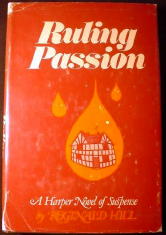
Nor does Pascoe have all the facts, as it turns out. This is a detective novel in which the characters and the relationships between them are as interesting to watch and follow as the unraveling of the case(s) itself/themselves — if not more so.
Ellie, in particular, not sure in the beginning that she really likes having a policeman as a boy friend, and detesting Dalziel in particular, finds herself warming to him, gradually and very much to her surprise.
As for Pascoe, he is pleased to learn along the way that he’s been promoted to Inspector. Does that mean that there’s life, he wonders, after Dalziel?
[POSTSCRIPT] I haven’t mention the long-running BBC TV show based on the series, but obviously, since it did run so long (60 episodes in all, between 1996-2007), it must have had quite a bit going for it. Comments and/or comparisons, anyone?
Tue 21 Apr 2009
REVIEWED BY WALTER ALBERT:
DEBORAH MORGAN – Four on the Floor. Berkley, paperback original; 1st printing, October 2004.
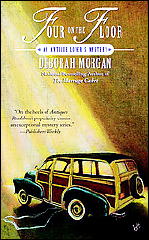
Jeff Talbot, former FBI agent and now an antiques “picker,” continues to be one of the more personable protagonists in the flourishing antiques mystery sub-genre, although my lack of interest in antique cars (or, indeed, of cars of any kind except as a way of getting from one bookstore to another) kept me from enjoying this as much as earlier entries.
Well, I didn’t really care about the subjects in a couple of the other entries either, but I figure that Morgan will hit one of my very limited interests one of these years.
When Jeff goes to pick up his restored vintage automobile, he finds four dead bodies that at first appear to be the result of an industrial accident. Of course, you won’t be surprised to hear that murder is the explanation and Jeff becomes a somewhat unwilling participant in the investigation.
A second, apparently unrelated case, is a mystery involving his parents, who were killed in an automobile accident when he was quite young, an enigma that suggests they were involved in a crime.
I must say that the conclusion Jeff leapt to initially here seemed off-the-wall to me, as indeed he is to learn that it was. The truth is more mundane, but a bit more interesting and changes the way he views his family and himself.
Smooth and entertaining. If you’re into antique cars, you may think this is the cat’s meow.
The JEFF TALBOT Antique-Lover’s Mystery Series —
1. Death Is a Cabaret. Berkley, pbo, November 2001.
2. The Weedless Widow. Berkley, pbo, October 2002.
3. The Marriage Casket. Berkley, pbo, October 2003.
4. Four on the Floor. Berkley, pbo, October 2004.
5. The Majolica Murders. Berkley, pbo, April 2006.
Tue 21 Apr 2009
ELIZABETH LOWELL – Blue Smoke and Murder.
Avon, paperback reprint; 1st printing, April 2009. Hardcover edition: William Morrow, June 2008.
This is one of those long (over 400 pages) novels of romantic suspense that I often buy because they look interesting and end up never reading because they simply look too long and maybe not so interesting after all when I get them home and out of the Barnes & Noble bag.
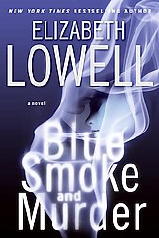
This one’s an exception – by which I do not mean exceptional, but it’s in many ways quite acceptable – because I did start reading it late one evening and didn’t put it down until I’d read about a quarter of the way through. Quite acceptable, that is, until … and I’ll get to that soon.
The background is what intrigued me at first – that being an inside look at the puffery and other hi-jinks (mostly illegal) that go on in the art business, or at least the auction end of it — which is maybe the most of it, at least as far as the where the money is.
Hence the “blue smoke” of the title, and there is quite a bit of it, since over 400 pages is quite a large number of pages to fill – but not in an uninteresting fashion, mind you.
The story: when Jill Breck, who is one of those highly efficient and independent young women who may appear more often in fiction than they do in the real world – she has a degree in art but spends her days as a rapid-river travel guide on the Colorado River – but when she finds herself in a jam, she calls on the highly expensive St. Kilda Consulting agency, whose operatives have figured in several other of Ms Lowell’s earlier books.
Jill’s great-aunt has died, under semi-suspicious circumstances, as it happens, although the authorities do not think so, but when Jill tries to investigate the value of a painting her great-aunt had had for a long time, she is both poopoohed badly and threatened, also badly.
It is the latter, the threat, this is, that has her concerned. St. Kilda sends Zach Balfour to act as her bodyguard and to otherwise give her all-around assistance. Bodyguards in novels like these often end up getting closer to the bodies they are guarding than would be professionally correct, and this novel is no exception — but without the abundance of graphic details that may inhabit other books of this same genre.
From a masculine perspective, I thought Jill would be a good person to learn to known, but that the two leading males were far too shallow: too much macho, not enough finesse. (Truth in Lending: I have neither.)
Nonetheless, the story is OK, if not more than adequate, until the action begins, which is when it goes off the track entirely. Why let the leading lady go off by herself into such an obvious trap? And what really happened anyway, other than the villain simply going nutso?
I’d have thought that a much more subtle ending was in order — there should have been a way to get some actual auction action involved. That’s what I was waiting for — not the usual TV stuff with cars, planes, police cars, guns and a dumpy sex ranch with a convenient ravine behind it. I can watch that sort of stuff on the boob tube almost every night in the week.
When I read a book I want something a tad more clever than this. More than a tad, in fact.
St. Kilda Consulting
1. Always Time to Die. Morrow, 2005; Avon, 2006.
2. The Wrong Hostage. Morrow, 2006; Avon, 2007.
3. Innocent as Sin. Morrow, 2007; Avon, 2008.
4. Blue Smoke and Murder. Morrow, 2008; Avon, 2009.
« Previous Page — Next Page »





















